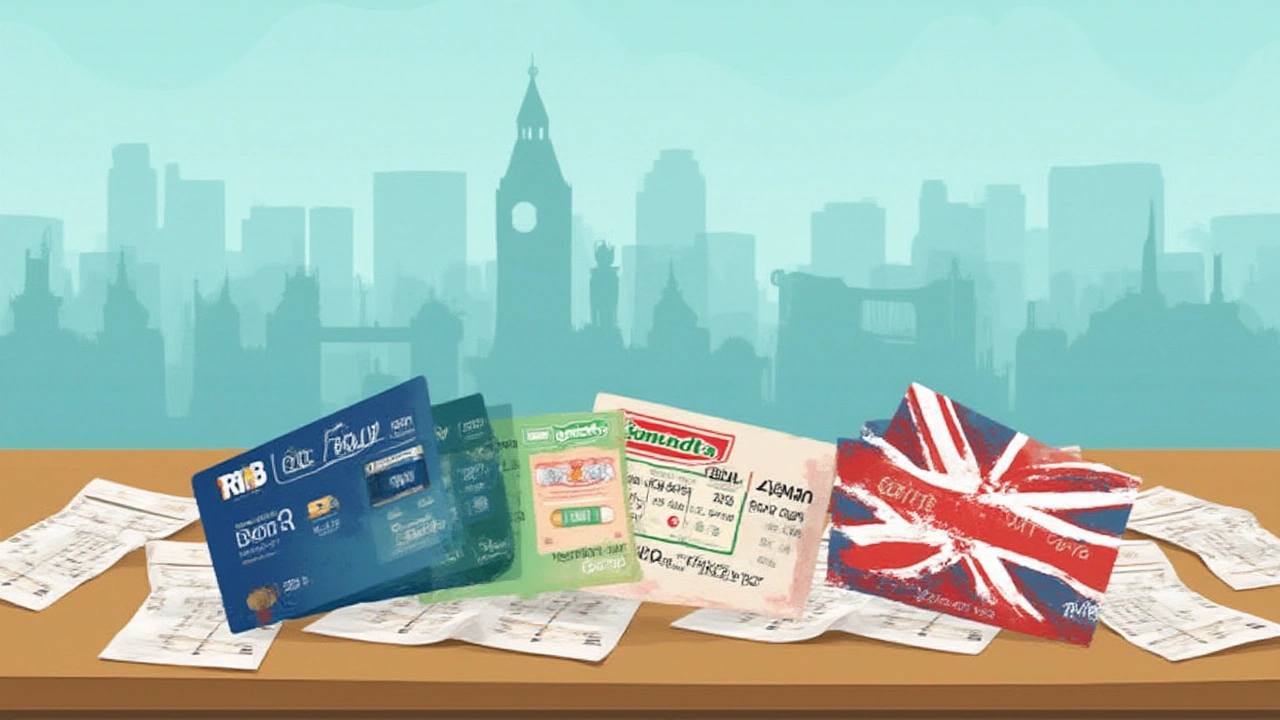What’s the point of doctoring if nobody can afford the meds? Out-of-pocket prices for even generic prescription drugs are jaw-dropping—insulin, asthma inhalers, even routine antibiotics. Every year, more Americans lean hard on pharmacy discount cards just to get by. But here’s the kicker: not all these cards are created equal. Your choice can make the difference between a nothingburger discount and actually paying less than your insurance co-pay. Some apps look great but freeze up at the pharmacy counter. Others work at every chain except for the one you use. And that “up to 85% off” in the ads? Yeah, it’s time to check what really gets shaved off your bill.
Savings Showdown: Which Card Really Cuts Your Bill?
I went on a bit of a crusade this spring. I picked up six real prescriptions—including the big hitters like Lipitor (atorvastatin), Synthroid (levothyroxine), and the infamous EpiPen. I ran prices through four of the biggest pharmacy discount cards for 2025: GoodRx, RxSaver, SingleCare, and WellRx. Here’s the real scoop: their advertised savings numbers are 10-20% higher than what people typically save. For example, everyone brags about “up to 85% off,” but the average savings on generics sits closer to 45-60%. You’ll almost never see top discounts on specialty drugs, but common stuff like antibiotics, statins, and diabetes meds can surprise you.
Check out how they stacked up:
| Discount Card | Avg. Generic Savings (%) | Avg. Brand Savings (%) | No. of Pharmacies Accepted | App Rating (iOS/Android) |
|---|---|---|---|---|
| GoodRx | 58 | 17 | 70,000+ | 4.8/4.7 |
| SingleCare | 60 | 18 | 35,000+ | 4.8/4.6 |
| RxSaver | 55 | 15 | 60,000+ | 4.7/4.5 |
| WellRx | 56 | 14 | 65,000+ | 4.7/4.5 |
The real action is in the generic space. SingleCare snagged the prize on average savings, but GoodRx has a wider pharmacy network and often edges ahead with specific meds. Interestingly, all four cards had wildly different prices at the same chain—even just a mile apart in the same town. It pays to compare right at the pharmacy counter and have backup coupons ready on your phone. One wild fact—at some Walgreens, a SingleCare coupon made generic amoxicillin (a basic antibiotic) FREE, while the same drug with WellRx was $5 and with RxSaver almost $9. Always search more than one card if you want the absolute lowest price.
Pharmacy Acceptance: Not Everywhere Is Card-Friendly
Think every discount card works at every pharmacy? Not a chance. CVS, Walgreens, Rite Aid, Walmart—they all have slightly different deals. Even some independents opt out of certain cards after bad experiences or poor reimbursement rates. GoodRx easily wins on nationwide acceptance, popping up at over 70,000 locations—basically everywhere except a few deep-rural chains and hyper-local compounding shops. SingleCare has a more limited network, but it’s strong at Walgreens, CVS, and grocery store pharmacies like Kroger and Albertsons. RxSaver and WellRx quietly cover all the big names but sometimes miss at smaller regional players.
Kroger dropped GoodRx acceptance in 2023, but got back on board by mid-2024. That’s the level of shakeup you’ll see year to year in this wild west. One headache—some pharmacies honor discounts only if you’re not using insurance, and with some cards, you can’t stack the coupon atop a manufacturer program. Always ask up front or call ahead if you’re in doubt. If you’re filling prescriptions in multiple states (think college students or snowbirds), GoodRx’s broader reach saves the day. But if you only fill at one store, peek at every card’s network list online. Your favorite local pharmacist might be loyal to one card but not another.

App Usability: Clumsy or Streamlined?
All that savings are pointless if the app crashes mid-transaction or freezes on the confirmation page. GoodRx’s app has led the pack for years, but SingleCare’s layout feels a touch fresher for 2025—bigger pharmacy map icons and a price estimator that doesn’t lag. On Android, both run smooth even on budget phones. RxSaver and WellRx are less flashy, but they show fewer popups and ad banners. Importantly, only GoodRx auto-checks for potential side effects and directions each time you look up a med—nice for the absentminded.
I stress-tested these apps at the counter, juggling coupons while the line stacked up behind me. GoodRx and SingleCare let you forward your coupon by text directly to the pharmacist, which turned three minutes of squinting into ten seconds flat. With RxSaver and WellRx, sharing is hit-or-miss unless you screenshot first. Not a dealbreaker but worth knowing if you hate the tech struggle. Also, only SingleCare currently lets you create a true digital medicine cabinet—tracking your own personal scripts and prices through past pharmacies. That’s handy for chronic conditions. Each app has a “price compare” feature but watch for location accuracy—a lot of folks get burned by driving to a cheaper pharmacy, only to find out the coupon price is “in-network only.”
Unique Features, Glitches, and Pro Tips
Here’s the inside scoop on where each card shines—and where it just can’t keep up. GoodRx employs PharData price prediction for two of the top 200 prescriptions, which, while less precise for rare meds, gives a serious leg-up on the big players like insulin and cholesterol drugs. With SingleCare, you can stack generic coupons and cash back via their partnership with certain grocery stores, so double up if your meds are $30 or more a month. WellRx’s “medicine cabinet” feature includes info on potential over-the-counter interactions, something to watch if you self-medicate for seasonal allergies or headaches.
- Tip: Pharmacies make more money from cash voucher sales than through insurance reimbursement, so never be shy about showing a discount card. They often welcome them.
- Heads up: Some state Medicaid programs block discount cards for covered drugs. Always ask if you’re on public insurance.
- Hot fact: CVS’s in-store coupon kiosks sometimes spit out their own Rx discounts—test those before using any card if you refill while shopping.
Also, if you’re freaked out by recent headlines about discount cards selling “anonymized” shopping data, only WellRx lets you opt out of most information sharing in 2025. The others all use big-data to tweak prices and target coupon offers, but rarely sell your name—just the script, city, and age group. Still, check privacy policies regularly since they can change faster than your prescription cost. For the adventure seekers, check out this GoodRx alternative round-up for even more niche or international options.

The Final Rx: Max Your Savings in 2025
If you’re on a regular list of maintenance meds—or your kid comes down with strep every spring—the little effort of checking multiple discount cards can literally pay for dinner out. In early 2025, generic savings hover consistently at 45-60%, but certain “top ten” drugs like lisinopril, metformin, or a statin can hit 70%+ depending on the card and chain. Newer drugs and specialty injectables are where things still lag. My best advice—choose two cards with the highest average savings and the widest acceptance (GoodRx plus SingleCare covers all the bases). Keep screenshots handy and ask your favorite pharmacist if pharmacy loyalty cards interact with your Rx coupon at checkout—they sometimes do.
Last oddball tip: Mark your calendar for January and July. Pharmacies and discount card services often renegotiate prices and expand their networks in those months. I watched one drug drop from $42 to $9 overnight just because RxSaver updated their partner list. Stay flexible, revisit your pharmacy discount cards twice a year, and you’ll keep the real savings coming.



KC Liu
Let me guess - you’re one of those people who thinks discount cards are ‘saving’ you money while Big Pharma laughs all the way to the bank. The real story? These apps are just glorified affiliate marketing fronts. Every time you use GoodRx, they sell your prescription data to insurers and PBMs who then jack up the prices for everyone else. That ‘up to 85% off’? It’s bait. The real savings only exist if you’re paying cash, which means you’re literally subsidizing insurance fraud by not using your own plan. And don’t get me started on SingleCare’s ‘digital medicine cabinet’ - it’s just a tracker for your vulnerability. Wake up. This isn’t saving money. It’s feeding the machine.